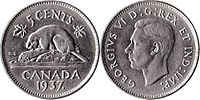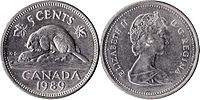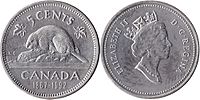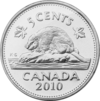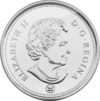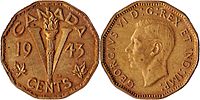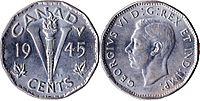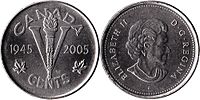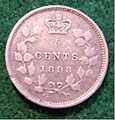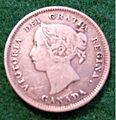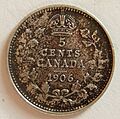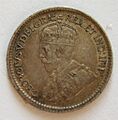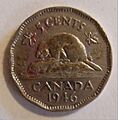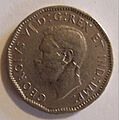Nickel (Canadian coin) facts for kids
| Canada | |
| Value | 0.05 CAD |
|---|---|
| Mass | 3.95 g |
| Diameter | 21.2 mm |
| Thickness | 1.76 mm |
| Edge | smooth (plain) |
| Composition | Nickel-plated steel 94.5% steel, 3.5% Cu, 2% Ni plating |
| Years of minting | 1858–present |
| Catalog number | – |
| Obverse | |
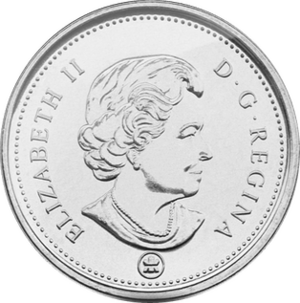 |
|
| Design | Elizabeth II, Queen of Canada |
| Designer | Susanna Blunt |
| Design date | 2003 |
| Reverse | |
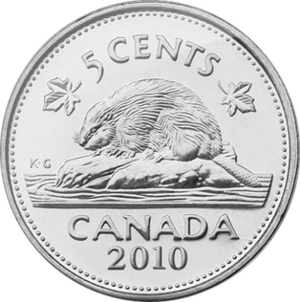 |
|
| Design | Beaver sitting on a rock |
| Designer | G.E. Kruger Gray |
| Design date | 1937 |
The Canadian five-cent coin, often called a nickel, is a coin worth five cents. That's one-twentieth of a Canadian dollar. This coin was designed similarly to the five-cent coin in the United States.
The nickel became the smallest-valued coin in Canada after the penny was stopped in 2013. Because prices have gone up over time, the nickel can't buy as much as it used to. Today, it's worth less than half a percent of the lowest hourly minimum wage in Canada.
The five-cent coin first appeared in 1858. It was a small, thin coin made of sterling silver. People used to call it a "fish scale" back then, not a nickel. The larger coin we know as the "nickel" was introduced in 1922. It was made of almost pure nickel metal (99.9%). These early nickel coins were magnetic because of their high nickel content.
During World War II, the coins were made from different materials. First, they used tombac (a mix of copper and zinc). Then, they switched to steel coated with chrome and nickel. After the war, they went back to pure nickel. Another steel version was made from 1951 to 1954 during the Korean War.
Because the price of nickel kept going up, the coins changed again in 1982. They started using cupronickel, which is a mix of copper and nickel, similar to the U.S. nickel. More recently, Canadian nickels are made from steel with a thin layer of nickel and a bit of copper. Older pure nickel coins (made before 1982) are slowly being taken out of circulation by the Royal Canadian Mint to be melted down. Only the cupronickel and modern plated steel coins are still used every day. This makes the older pre-1982 nickels special for coin collectors!
From 1942 to 1963, Canadian five-cent coins had a unique 12-sided shape. This was done to help tell the copper-colored tombac coins apart from pennies. Even after they stopped using tombac, the 12-sided shape stayed for another 19 years.
The Royal Canadian Mint makes these coins at its factory in Winnipeg.
Contents
History of the Canadian Nickel
The very first Canadian five-cent coins were made in London in 1858. This was for the new currency of the Province of Canada. These coins were similar in size and material to the American coins of that time, like the half dime. Even though the U.S. changed its five-cent coin to a larger copper-nickel coin in 1866, Canada kept its small silver five-cent coins until 1922.
All Canadian coins were made in England until 1908. They were made at the Royal Mint in London or the Birmingham Mint. After 1908, the Ottawa branch of the Royal Mint opened in Canada. Since then, almost all Canadian coins have been made in Canada.
In 1920, the amount of silver in Canadian coins was reduced because silver prices went up. Then, in 1922, silver was completely removed from the five-cent coin. It was replaced with a coin made of pure nickel, which was similar in size to the American nickel. Canada was the world's biggest producer of nickel at the time. Since then, this coin has been known as the "nickel."
The five-cent coin of Newfoundland (which was a separate country before joining Canada) stayed silver until 1947.
The nickel's material has changed many times, especially during World War II and the Korean War. Nickel was needed for making armor during these wars. So, from late 1942 to 1943, the coins were made of tombac. This was a mix of 88% copper and 12% zinc. In 1944 and 1945, and again from 1951 to 1954, the coins were made of steel that was plated with nickel and then chromium. The plating was done before the coin blanks were stamped, so the edges of these coins often looked dull or even rusted. After both wars, they went back to pure nickel.
In 1982, the Canadian nickel started using the same copper-nickel mix as the American coin. This meant the Canadian "nickel" actually had less nickel than most other Canadian coins, except for the cent. Since late 2000, the nickel is usually made from plated steel. Now, the plating is done after the coin blanks are cut, so the edges are also covered. Some coins from 2001 and 2006 were made of cupronickel. You can tell them apart because they don't have a "P" under Queen Elizabeth's picture, and they are not magnetic.
The 12-sided shape of the nickel started with the 1942 tombac coins. This was probably to help people tell it apart from the cent once it got old and dirty. Even though tombac was replaced by steel in 1944, the coins stayed 12-sided until 1963.
All these Canadian coins were lighter than the U.S. five-cent coin, which is made to weigh almost exactly five grams. Canadian pure nickel five-cent coins were nearly half a gram lighter. Today's steel coins are a full gram lighter than U.S. "nickels."
The Rare 1921 Five-Cent Coin
The five-cent coins from 1921 are some of the rarest and most sought-after Canadian coins. They are even called "The Prince of Canadian Coins." Experts believe there are only about 400 to 480 of these coins known today. In May 1921, the Canadian government decided to switch to the larger nickel coin. Because of this, most of the 1921 coins that were made were melted down. One of the best-known examples of this coin sold for US$115,000 at an auction in 2010. It was then sold again for $160,000 in 2012 to a private collector.
Types and Specifications of the Nickel
Here's a look at the different types of Canadian five-cent coins over the years, including what they were made of and their size.
| Different Types of Nickels | ||||
|---|---|---|---|---|
| Image | Years | Mass | Diameter | Composition |
| 1858–1901 | 1.16 g | 15.5 mm | 92.5% silver, 7.5% copper | |
| 1902–1910 | 1.16 g | 15.5 mm | 92.5% silver, 7.5% copper | |
| 1911–1921 | 1.17 g | 15.5 mm | 92.5% silver, 7.5% copper (1911–1919) 80% silver, 20% copper (1920–1921) |
|
| 1922–1936 | 4.54 g | 21.21 mm | 99.9% nickel | |
| 1937–1942 | 4.54 g | 21.21 mm | 99.9% nickel | |
| 1942–1945 | 4.54 g | 21.3 mm | 88% copper, 12% zinc ("tombac") (1942–1943) Chrome plated steel (1944–1945) |
|
| 1946–1952 | 4.54 g | 21.3 mm | 99.9% nickel (1946–1951) Chrome plated steel (1951–1952) |
|
| 1953–1964 | 4.54 g | 21.3 mm | Chrome plated steel (1953–1954) 99.9% nickel (1955–1964) |
|
| 1965–1981 | 4.54 g | 21.3 mm | 99.9% nickel | |
| 1982–1989 | 4.6 g | 21.2 mm | 75% copper, 25% nickel | |
| 1990–2001, 2006 (No "P" on obverse) |
4.6 g | 21.2 mm | 75% copper, 25% nickel | |
| 1999–2003 (With "P") |
3.95 g | 21.2 mm | 94.5% steel, 3.5% copper, 2% nickel plating | |
|
|
2003–present (With RCM logo on obverse) |
3.95 g | 21.2 mm | 94.5% steel, 3.5% copper, 2% nickel plating |
Special Commemorative Nickels
Some Canadian nickels have special designs to celebrate important events.
The "Victory nickel," made from 1943 to 1945, was the first special circulating Canadian coin (besides some dollars). Its back shows a flaming torch and a large "V." The "V" stands for both Victory and the coin's value (five in Roman numerals). The edge of the coin even had the message "We win when we work willingly" in Morse Code. This design was used again in 2005 to celebrate the 60th anniversary of V-E Day.
In 1951, a special five-cent coin was made to celebrate 200 years since the discovery of nickel. It showed a nickel refinery. But because the Korean War started, they stopped making this coin to save nickel for the war effort. This led to a second, regular 1951 "nickel" made of plated steel.
In 1967, all Canadian coins got a special design for the Canadian Centennial (100 years since Canada became a country). The nickel featured a rabbit!
Since 1996, some special collector sets (called proof sets) have five-cent coins made of sterling silver. Some other special commemorative five-cent coins are also made of sterling silver.
| Image | Year | Theme | Artist | Mintage | Special notes |
|---|---|---|---|---|---|
| 1943 | Victory (Tombac) | Thomas Shingles | 24,760,256 | Made to support the war effort. The message "We Win When We Work Willingly" is written in Morse code on the coin's edge. | |
| 1944–1945 | Victory (Steel) | Thomas Shingles | 11,532,784 (1944) 18,893,216 (1945) |
Made to support the war effort. The message "We Win When We Work Willingly" is written in Morse code on the coin's edge. | |
| 1951 | Discovery of Nickel | Stephen Trenka | 9,028,507 | Celebrated 200 years since nickel was discovered. Shows a nickel refinery. | |
| 1967 | Canadian Centennial | Alex Colville | 36,876,574 | Features a hopping rabbit. Dated 1867–1967. | |
| 2005 | Victory anniversary | Thomas Shingles | 59,269,192 | 60th anniversary of the end of World War II. The edge of this coin is smooth, unlike the 1943–1945 version. Dated 1945–2005. | |
| 2017 | Canada 150 | Gerald Gloade | 20,000,000 | 150th anniversary of Canada becoming a country. Features a beaver design inspired by Indigenous art. The coin's theme is "Our Passions." Dated 1867–2017. |
Images for kids



